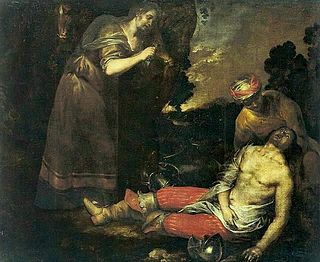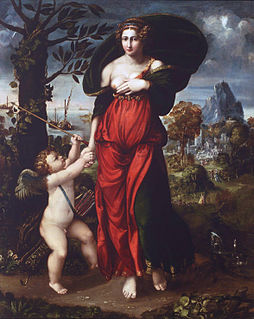
Camillo Filippi (died 1574) was an Italian painter who flourished about the middle of the 16th century.

Camillo Filippi (died 1574) was an Italian painter who flourished about the middle of the 16th century.
Filippo was born in Ferrara. He was a disciple of Dosso Dossi, and painted historical works with some success. The Annunciation in the choir of the church of Santa Maria in Vado at Ferrara is attributed to Filippo; as is the Trinity in the Church of the Jesuits. He painted for the fresco cycle of Oratorio dell'Annunziata, Ferrara. His death took place in 1574. His son, Sebastiano Filippi (Il Bastianino), became a prominent local painter. His younger son Cesare Filippi was also a painter. [1]
This article includes a list of general references, but it remains largely unverified because it lacks sufficient corresponding inline citations .(April 2017) (Learn how and when to remove this template message) |
The School of Ferrara was a group of painters which flourished in the Duchy of Ferrara during the Renaissance. Ferrara was ruled by the Este family, well known for its patronage of the arts. Patronage was extended with the ascent of Ercole d'Este I in 1470, and the family continued in power till Alfonso II, Ercole's great-grandson, died without an heir in 1597. The duchy was then occupied in succession by Papal and Austrian forces. The school evolved styles of painting that appeared to blend influences from Mantua, Venice, Lombardy, Bologna, and Florence.
Sebastiano Filippi was an Italian late Renaissance – Mannerist painter of the School of Ferrara.

Giulio Cesare Procaccini (1574–1625) was an Italian painter and sculptor of the early Baroque era in Milan.

Camillo Procaccini was an Italian painter. He has been posthumously referred to as the Vasari of Lombardy, for his prolific Mannerist fresco decoration.

Giuseppe Mazzuoli was an Italian painter of the Mannerist period, active mainly in the court of Alfonso II d'Este of Ferrara.

Francesco Costanzo Cattaneo was an Italian painter of the Baroque period, born and mainly active in Ferrara. He is also known as Costanzo or Costanza Cattanio.
Giuseppe Caletti or Calletti was an Italian painter and engraver of the Baroque period, active in Ferrara and Cremona. He often painted religious themes in a genre like dress and surroundings, including the theme of Bacchanalia like Titian.
Giovanni Francesco Braccioli was an Italian painter of the Baroque period, mainly active in Ferrara.

Luciano Borzone was an Italian painter of a late-Mannerist and early-Baroque styles active mainly in his natal city of Genoa.

Francesco Brizio (1574–1623) was an Italian painter and engraver of the Bolognese School, active in the early-Baroque.
Camillo Rizzi (1580–1618) was an Italian painter of the Renaissance period, active mainly in Ferrara. He was a pupil of the painter Ippolito Scarsella.
Giovanni Battista Buonocore was an Italian painter of the Baroque period. He became Rector (1679), then Principe (1698) of the Accademia di San Luca of Rome.

Antonio Randa was an Italian painter of the classicist period, active in Ferrara, Modena, Rovigo, Florence, Comacchio and his native Bologna.

Ercole Procaccini il Giovane was an Italian painter of the Baroque period.

Ercole Procaccini the Elder was an Italian painter of the Renaissance period, mainly active in Milan.

Francesco Vaccaro also known as Vaccari, Vacari was an Italian painter and engraver of the Baroque period, who trained in his native Bologna under Francesco Albani. He was chiefly known as a painter, from his landscape and architectural views.

Battista Dossi, also known as Battista de Luteri, was an Italian painter who belonged to the Ferrara School of Painting. He spent nearly his entire career in service of the Court of Ferrara, where he worked with his older brother Dosso Dossi. It is believed that Battista worked in the Rome studio of Raphael from 1517 to 1520. Battista’s students include Camillo Filippi.
Antonio Bonfanti was an Italian painter. He was also called Il Torricella. He was a native of Ferrara, where he painted a Presentation of Mary at Temple and Dispute among Doctors for the chancel of the church of San Francesco and a Holy Family for the church of La Santissima Trinità. He was a pupil or follower of Guercino. His brother Giulio was also a painter.
Cesare Filippi was an Italian painter. He was the younger son and pupil of Camillo Filippi. Cesare was born at Ferrara in 1536. He assisted his father and brother Sebastiano in their works, and excelled in painting heads and grotesques in the ornamental style, although he sometimes attempted historical subjects, which are very feeble imitations of the style of his brother. Such is his picture of the Crucifixion in the church of La Morte.

Bernardino Zaganelli, also Bernardino di Bosio Zaganelli and Bernardino da Cotignola, was an Italian painter, of the Renaissance period.
| Wikimedia Commons has media related to Camillo Filippi . |
| | This article about an Italian painter born in the 16th century is a stub. You can help Wikipedia by expanding it. |